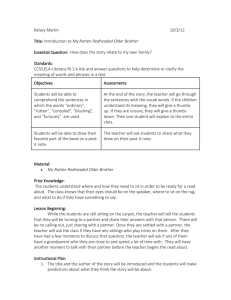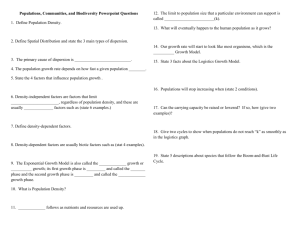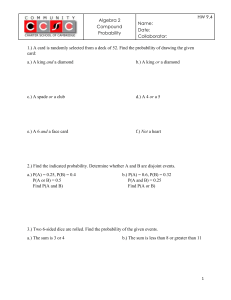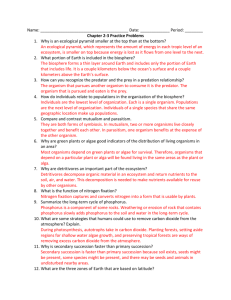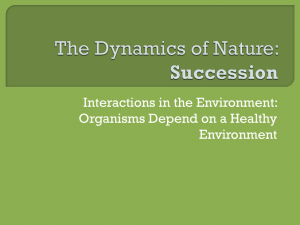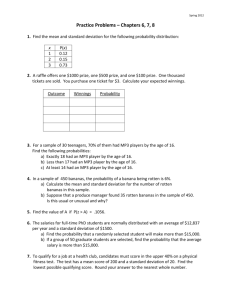Ecological Succession in a Rotten Log
advertisement
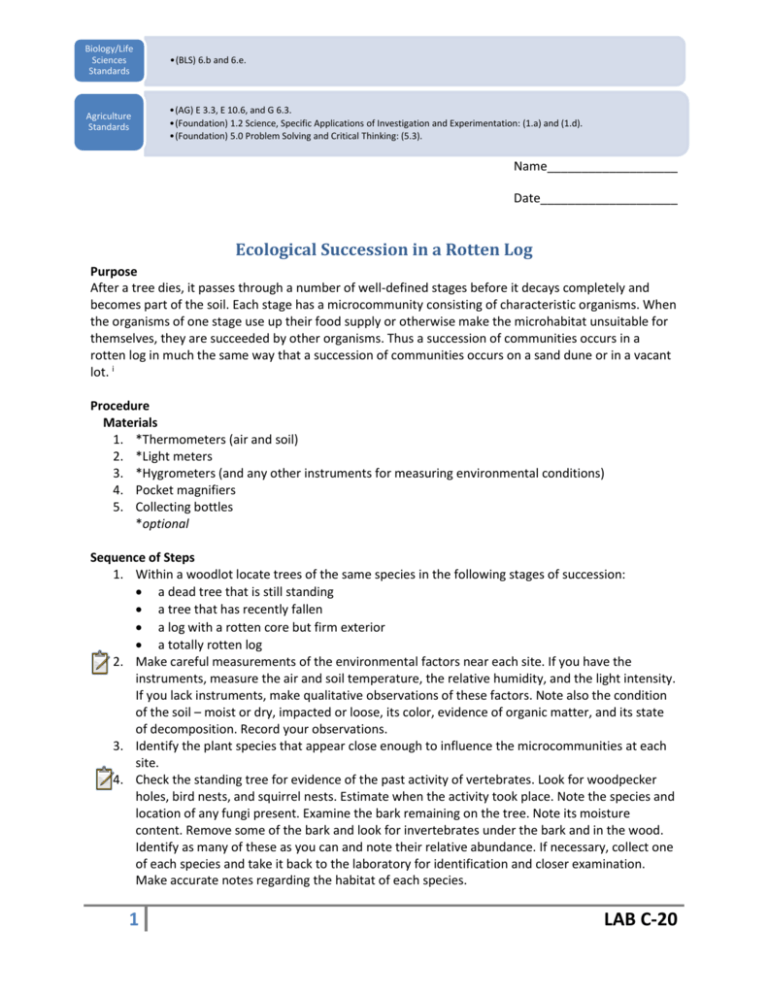
Biology/Life Sciences Standards •(BLS) 6.b and 6.e. Agriculture Standards •(AG) E 3.3, E 10.6, and G 6.3. •(Foundation) 1.2 Science, Specific Applications of Investigation and Experimentation: (1.a) and (1.d). •(Foundation) 5.0 Problem Solving and Critical Thinking: (5.3). Name___________________ Date____________________ Ecological Succession in a Rotten Log Purpose After a tree dies, it passes through a number of well-defined stages before it decays completely and becomes part of the soil. Each stage has a microcommunity consisting of characteristic organisms. When the organisms of one stage use up their food supply or otherwise make the microhabitat unsuitable for themselves, they are succeeded by other organisms. Thus a succession of communities occurs in a rotten log in much the same way that a succession of communities occurs on a sand dune or in a vacant lot. i Procedure Materials 1. *Thermometers (air and soil) 2. *Light meters 3. *Hygrometers (and any other instruments for measuring environmental conditions) 4. Pocket magnifiers 5. Collecting bottles *optional Sequence of Steps 1. Within a woodlot locate trees of the same species in the following stages of succession: a dead tree that is still standing a tree that has recently fallen a log with a rotten core but firm exterior a totally rotten log 2. Make careful measurements of the environmental factors near each site. If you have the instruments, measure the air and soil temperature, the relative humidity, and the light intensity. If you lack instruments, make qualitative observations of these factors. Note also the condition of the soil – moist or dry, impacted or loose, its color, evidence of organic matter, and its state of decomposition. Record your observations. 3. Identify the plant species that appear close enough to influence the microcommunities at each site. 4. Check the standing tree for evidence of the past activity of vertebrates. Look for woodpecker holes, bird nests, and squirrel nests. Estimate when the activity took place. Note the species and location of any fungi present. Examine the bark remaining on the tree. Note its moisture content. Remove some of the bark and look for invertebrates under the bark and in the wood. Identify as many of these as you can and note their relative abundance. If necessary, collect one of each species and take it back to the laboratory for identification and closer examination. Make accurate notes regarding the habitat of each species. 1 LAB C-20 5. Examine the newly fallen log. Compare the ease with which bark can be removed from it and the standing tree. Note the moisture content and hardness of the wood. Compare these to the standing tree. Check for fungi, mosses, lichens, and herbaceous plants. Study the invertebrates, as in 4. Record your observations. 6. Approach the partially rotten log slowly. Look around and under it for vertebrates like snakes and salamanders. Look for signs of animal life such as tunnels, runways, nesting sites, and food catches. Remove part of the hard outer shell. Break this apart and make observations on the invertebrate population, as in 4. Search through the rotting core for invertebrates, snakes, and salamanders. Note the color, moisture content, and odor of the rotting core. Describe its state of decomposition. Check for fungi, mosses, lichens and herbaceous plants. 7. Examine the totally rotten log as you did the core in 6. Compare the color, moisture content, odor, stage of decomposition, plants, and animals of the two stages. Observations Table 1. Observations of woodlot samples General Observations: Air temperature, soil temperature, humidity, light intensity, etc. Dead tree (still standing) Recently fallen tree Log with rotten core but firm exterior Totally rotten log Evidence of past vertebrate activity Examine Bark Observations after bark is removed. Observations of invertebrates. 2 LAB C-20 1. Describe the microsuccession that occurs in a rotten log from the time the tree dies to the time it becomes part of the soil. 2. Which organisms were most abundant at each stage? Why? 3. Which stage had the greatest diversity of life? Why? 4. Account for the succession that occurs by relating the changing biotic factors to the changing abiotic factors. 5. Make up as many food chains as you can for each of the four stages. 6. What organisms are responsible for the odor of a rotting log? What niche do they occupy? 7. What do you think is the most important niche in a fallen log microcommunity? Why? i (2008).Ecological Succession in a Rotten Log. Prentice Hall, Inc. 3 LAB C-20
